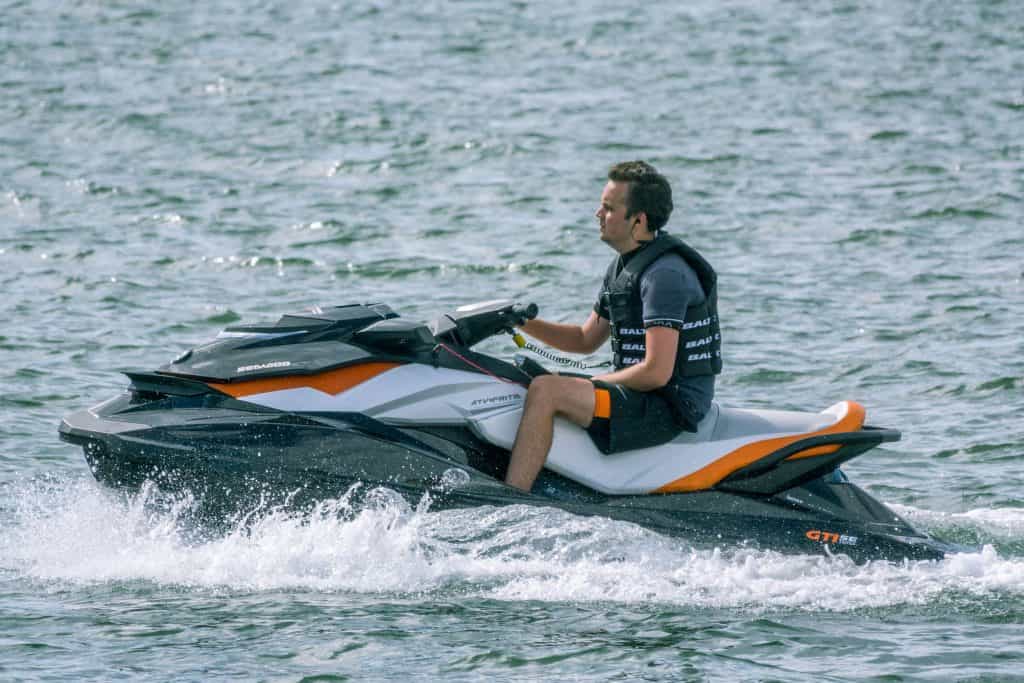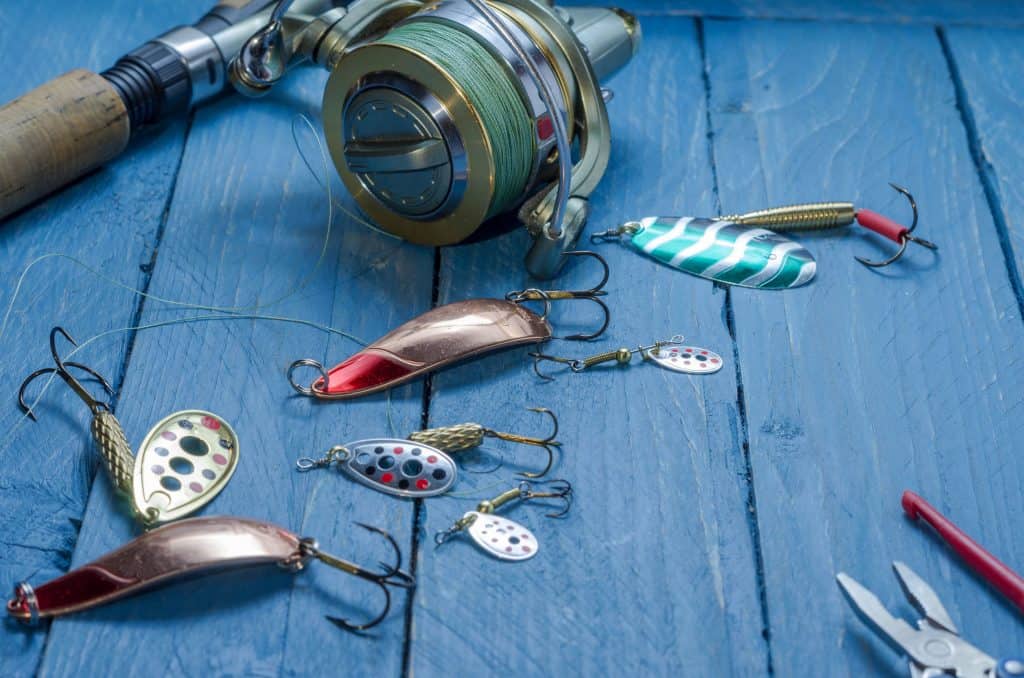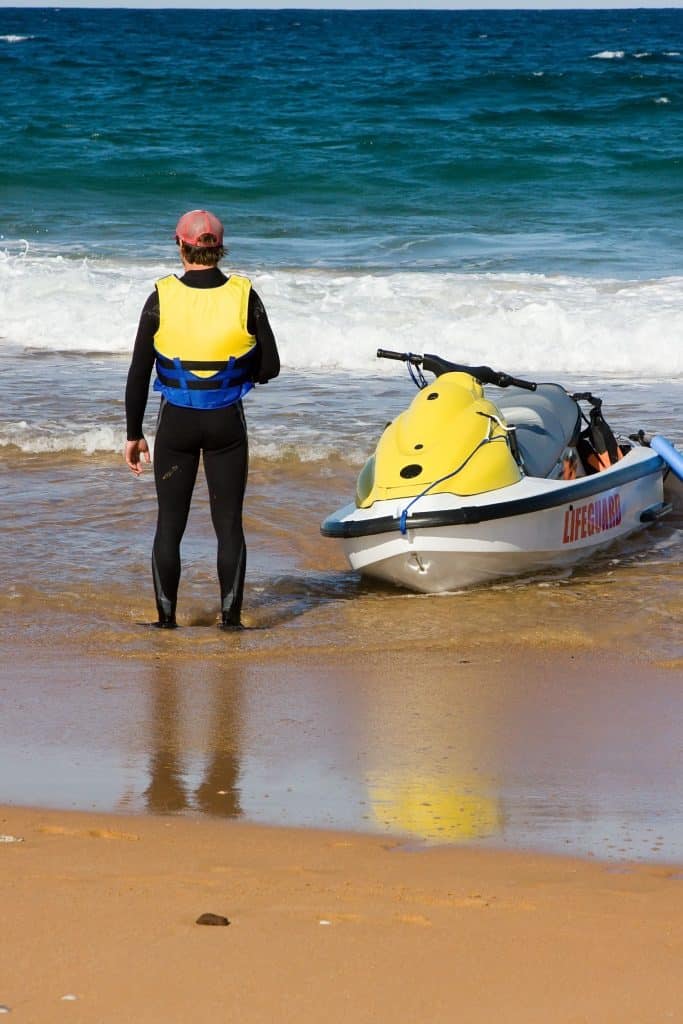

In the many years since their invention, jet skis have become more and more popular. With more people paying attention to these watercraft, it makes sense that they would be looking for new ways to put them to use.
When they first came out in the early 1970s, jet skis had a very limited scope of use. There were only stand-up models, and they were pretty stiff when compared with the models produced today.
Since then, jet skis have come to be used in a huge variety of ways. They are used to perform backflips in freestyle competitions or tow water skiers and wakeboarders and they are even used in performing rescue missions.
Another newer use of jet skis that is a bit more relaxed than the others mentioned is fishing. Using jet skis to fish has grown more popular over the last few years, and it is easy to see why.
While you probably could just grab a rod and jet out into the sea or to the middle of a lake, it would be wiser to put more preparation into it. In this article, we will look at how to get ready for a fishing outing on a jet ski.
Visit our Jet Ski Page for More Great Content!
The Essentials
There are a few items that are necessary for every angling trip, but when using a jet ski it is not just the fishing gear that needs to be considered. We can take a look at some things that I consider to be essential items for fishing on a jet ski, both specifically for fishing and just for general jet ski use.
Related Reading: Do you need a license to ride a Jet Ski?
Jet Ski Safety
Before leaving the shore or the dock, you should always make sure that you are equipped to mitigate an emergency should a situation arise.

Lifejacket
First and foremost, you should always have a lifejacket, and in most cases, you should be wearing it all the time. No matter how good of a swimmer you think you are, it is always good practice to wear a lifejacket the whole time you are on the water.
If something happens and you have to abandon ship, you will be glad you have it. You will also be glad you are wearing it if you are stopped by the authorities, as in most places it is required by law to wear a lifejacket the entire time that you are on a jet ski.
Check out our top picks for jet ski life jackets!
Fire Extinguisher
Another thing that every watercraft should have onboard is a fire extinguisher. That goes for jet skis just as much as it does for boats. The benefits of having a fire extinguisher are pretty obvious. If the engine or any part of the jet ski catches fire, it is preferable to use an extinguisher to put out the flames as opposed to trying to sink the watercraft
Emergency Signal
If you find yourself in an emergency situation, you are not going to want to try to handle it all on your own. But in large bodies of water, it can be difficult to recognize that someone is in need of help from a great distance.
That is why it is important to have something that can get the attention of others from far away. Flares are a great tool to use to be seen from far away and are generally seen as a signal of distress. An orange flag can also serve as a visual signal, though it might take longer to be noticed than a flare would.
An air horn or a loud whistle will attract attention pretty handily.
If you find yourself stranded, these items will likely reduce the amount of time that you have to wait for rescue to arrive.

Necessary Fishing Gear
Now that the safety lecture is done, we can start looking at gear for the actual fishing.
Fishing Rod Holder
Hopefully, when thinking about fishing gear, a fishing rod is the first thing that comes to mind. Bowfishing is a thing, and there are even rodless reels now, but we are just going to focus on rod fishing.
A lot of people like to bring more than one rod out with them to increase their chances of having a bite. Before casting three lines at once, though, you might want to look into the regulations in your area. There are some limitations as far as the maximum number of poles you can use at once depending on where you are.
However, even if you plan on just using one rod, a holder is great to have on the jet ski. You can keep it there while operating the jet ski because driving with one hand is a little inconvenient.
There are a few different styles of rod holders, and which kind you use will probably come down to personal preference. Here are a couple of examples of rod holders:
- Clamp-style rod holder- This type of rod holder uses a simple clamp to attach to railing of various sizes. Rod holders of this type might not be the best for jet skis as there are not many places on a jet ski with railing that could be used.
The Harbor Mate Stainless Steel Fishing Rod Holder is an example of a clamp-style rod holder. - Suction cup-style rod holder- Suction cup rod holders are good options for jet skis because they can be attached in various places and they will not cause damage to the vessel. You also won’t need to drill holes for screws or buy something else to attach it to.
The Rod Mounts Sumo Suction Rod Carrier and the SeaSucker Rod Holder are a couple of examples of this type of rod holder. - Attach to another product- This type of rod holder is not one that you can use by itself. You have to buy another product that the rod attaches onto, usually a cooler. These are good options if you plan on getting the cooler that they are used with.
The YETI® Rod Holster and the Sea-Doo Quick-Attach Rod Holder both attach onto coolers made by their same respective company.
Cooler
A cooler might not necessarily be essential, but if you want to keep any of the fish that you catch it will be a good idea to have one. Holding a rod in your hand while driving a jet ski would be difficult, but holding a fish would likely prove to be even trickier. That is why having a cooler is a good idea.
There are coolers of many different sizes, so the one you get will depend on what you expect to catch and how many fish you intend to bring back with you.
When it comes to coolers, there are a couple of directions to go. You can either purchase coolers/cooler racks that have been specifically made to go on the back of jet skis, or you can build your own rig.
If you are not very handy, buying the premade stuff might be a better option. They can be a bit pricy, but they are functional and you can rest assured knowing that they will work. Here are a couple of jet ski racks that hold coolers as well as have fishing rod holders attached:
Jet Ski Fishing Rod Rack and Cooler Combo by Extreme Max Store
Jet Ski Fishing Rod Rack & Cooler Holder Combo by Plattinum Products
If you do feel up to the challenge of building your own rack, using PVC pipe is often a good idea. It is fairly cheap and easy to work with.
Here are a couple of videos that will give you some ideas of where to get started and how they can turn out:
Anchor
An anchor is useful because it keeps your jet ski from drifting away from your favorite fishing spot. If you do not want to have to readjust your position every few minutes, an anchor is a worthwhile investment.
Nonessential But Useful Items
Now we will look at a few items that are definitely helpful on a fishing excursion but are manageable to do without.
Visit our Fishing Page for more Great Content!
Fish Finder
Back in the good old days, people didn’t have the technology that we do now. They just had to use trial and error to find out where the best fishing spots were. Nowadays we can look at a little screen and see exactly what is below us in the water.
Fish finders can be very useful, especially in an area that you are unfamiliar with. Some jet skis come with a fish finder preinstalled, but even most of the ones that do not come with one can have one installed.
As useful as they are, though, fish finders are not a necessity. People have been fishing for thousands of years, so if you do not have one it will be fine.
GPS
A GPS falls into the same category as a fish finder. It is not entirely necessary, but it can be useful for exploring new areas without getting lost. There are even options for fish finder/GPS combos, so getting them as a two in one package might be worthwhile.
Jet Ski Sun Shade
It might look a little excessive, but just like boats, there are sun shades made for jet skis. You might want to get one if you are extra sensitive to sunlight or just do not want to have to reapply sunscreen every hour. Personally, I would just wear a hat.
Extra Gas
Depending on how long you want to stay our and how far you want to go, bringing extra gas is definitely a good idea. In theory, you could just jet out to one spot, fish there for the entire duration of the trip, and then jet back to shore. Or you would just have to keep an extra close eye on your fuel level all day.
Having extra gas means that you can spend more time on the water and visit more fishing spots without worrying about running out of fuel and being stranded.
Like the other accessories, you can either make your rig so that it accommodates fuel along with the cooler, or buy specially made gas cans for jet skis.
Watertight Storage Bag
Most jet skis have watertight storage compartments, but they are often under the seat or under the hood. This can make accessing them just a little inconvenient when on the water.
With a watertight storage bag, you can keep a few items like a phone or a camera in a more accessible location without worrying about ruining them. That is, as long as you don’t drop them in the water.
These are only a few ideas of things to improve your jet ski fishing experience. There are a lot more out there, and as you fish on your jet ski more and more you will be able to think of new things to add to your set up to make each trip better and better.
Why Fish With a Jet Ski
You might be asking, why fish with a jet ski? There are all kinds of boats that can be used, so why not go with a boat?
Boats are great for fishing, but jet skis do offer some advantages. People who fish on jet skis point out the same things that people do who use jet skis over boats for other activities like towing.
The main appeal of a jet ski over many kinds of boats is the size. Since a jet ski is so small, it is easier to transport and store. A large boat requires a large truck or SUV to haul it, but a jet ski can be hauled by a sedan.
A jet ski is cheaper to store at a marina if you decide to leave it on the water. If you do take it home, a jet ski can fit in a garage and leave room for other items. I have friends who keep their boat in their garage, and it takes up the entire 3rd space. Plus it’s a hassle to get in and out of there.
While on the water, the size of a jet ski means that you can easily access areas like inlets and coves that might be harder to navigate on a large boat. Of course, a kayak would make easy work of tight spaces too, but you won’t get around as fast in one.
Since jet skis use impellors instead of external propellors, you can also go into shallow areas and even right up to shore without worrying about causing any damage to the vessel.
Finally, jet skis are pretty cheap when compared to a lot of boats. New jet skis aren’t what most people would consider super cheap, but you can find used ones at great prices. Some used boats still cost tens of thousands of dollars. There are cheaper boats, but at that level, a jet ski might just be a higher quality product.

As you can see, there are many reasons to fish with a jet ski. There are also lots of ways to do it. I would recommend starting out simple. Bring a rod and a cooler the first time and see what it’s like. After that, start trying out different accessories that you feel will improve your personal experience.
Do Jet Skis Scare Fish Away?
Jet skis can potentially scare fish away when fishing from them. Still, the extent to which they do so depends on several factors, including the type of fish you’re targeting, the noise level of the jet ski, and your approach.
- Noise Level: Jet skis are known for their noise, which can be disruptive to fish. Fish have sensitive hearing and can be startled or frightened by loud and sudden noises. If you’re riding a particularly noisy jet ski, it’s more likely to scare fish away in the vicinity.
- Fish Species: Some fish are more sensitive to disturbances than others. Species like trout and other freshwater fish in quiet, calm waters may be more easily scared away by the noise and disturbance of a jet ski. In contrast, some saltwater species are more accustomed to boat traffic and may not be as affected.
- Approach and Speed: The speed and proximity at which you approach fishing areas can also influence whether fish are scared away. If you suddenly accelerate or drive too close to a site where you plan to fish, you’re more likely to disturb the fish. Slow, careful approaches may minimize the disturbance.
- Time of Day: Fish behavior can vary depending on the time of day. Many anglers find that fish are more active during dawn and dusk when there is less boat traffic, which might make them more sensitive to disturbances during these times.
When you find the fishing spot, it’s best to turn off the jet ski’s engine and drop a small anchor. This way, you can still fit into smaller areas while not scaring all the fish away while you fish.
Best Jet Skis and Average Cost
There are quite a few manufacturers of jet ski, some being better quality than others. Some of the brands we recommend are Sea-Doo, Yamaha, and Kawasaki.
Depending on what model you choose will determine your price. You could spend anywhere from $8,000 to $18,000 for a new one. Below are a few possibilities for your use. For a more comprehensive list of popular jet ski models and prices, click here!
- Sea-Doo Fish Pro Scout
- Yamaha FX Cruiser HO
- Kawasaki Ultra 310 LX
Don’t forget to check your local listings for used jet skis. Many times you can find great deals on some really nice and barely used jet skis.
How Far Can You Fish Off-Shore on a Jet Ski?
A jet ski’s maximum ocean range varies on factors like experience, sea conditions, and fuel. Novices should stick closer to shore. Experienced riders can go about 10-20 nautical miles, but conditions matter:
- Sea Conditions: Calm seas are best; rough waters reduce range.
- Fuel Capacity: Know your jet ski’s tank size and efficiency. On average, a jet ski can cover about 50-100 nautical miles on a full tank in safer conditions. Keep in mind that rougher sea conditions, speed load, and unexpected challenges will use more of your gas.
- Speed and Load: Speed and passengers affect fuel use.
- Going Beyond: Deeper waters have challenges, like tall waves and storms. Jet ski are not necessarily know for their stability in rough waters and should be avoided when going farther out to sea.
On average, a jet ski may cover 50-100 nautical miles on a full tank in safe conditions. Plan to use about two-thirds of your fuel, leaving one-third as a reserve for unexpected situations. Safety is paramount; be aware of your jet ski’s abilities and plan accordingly.
